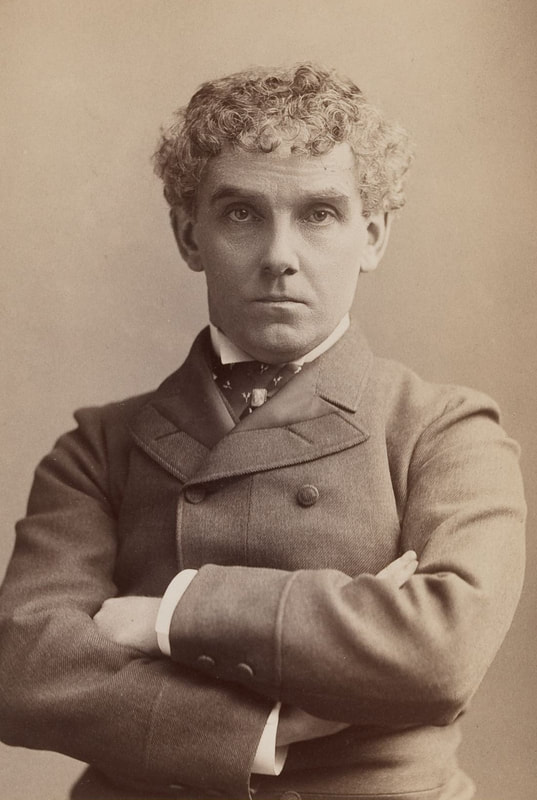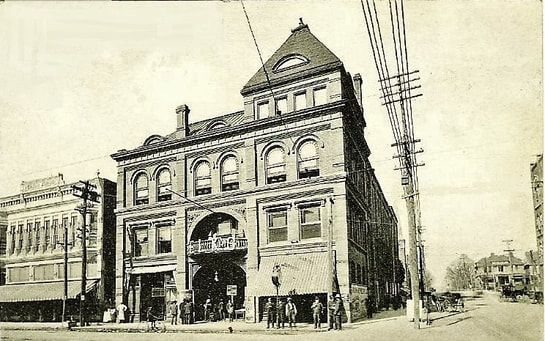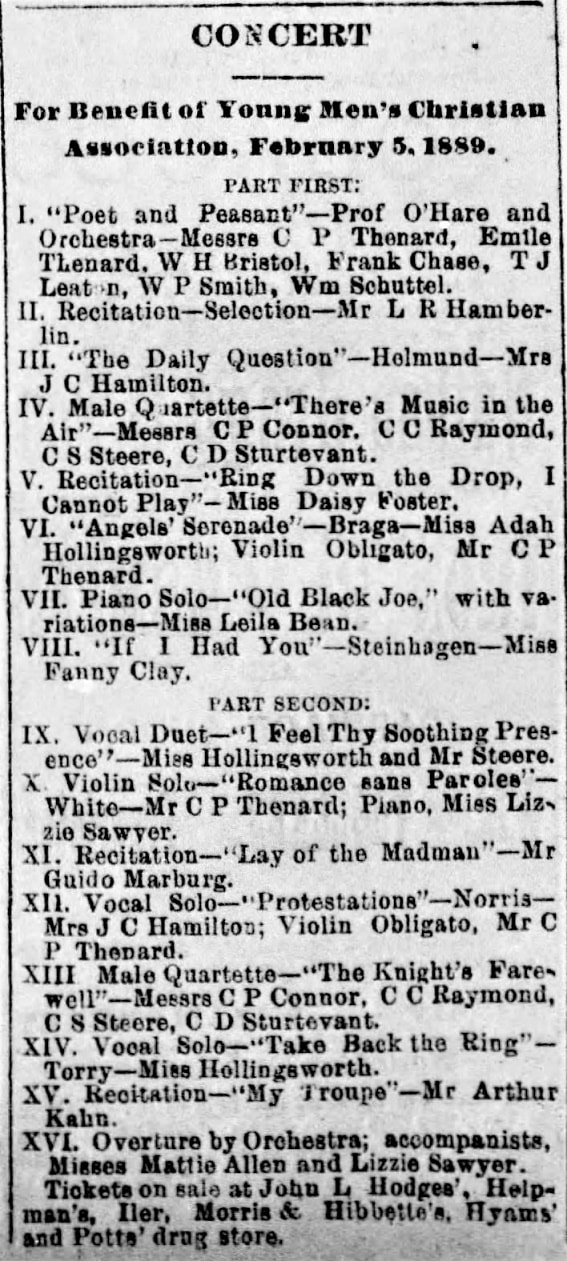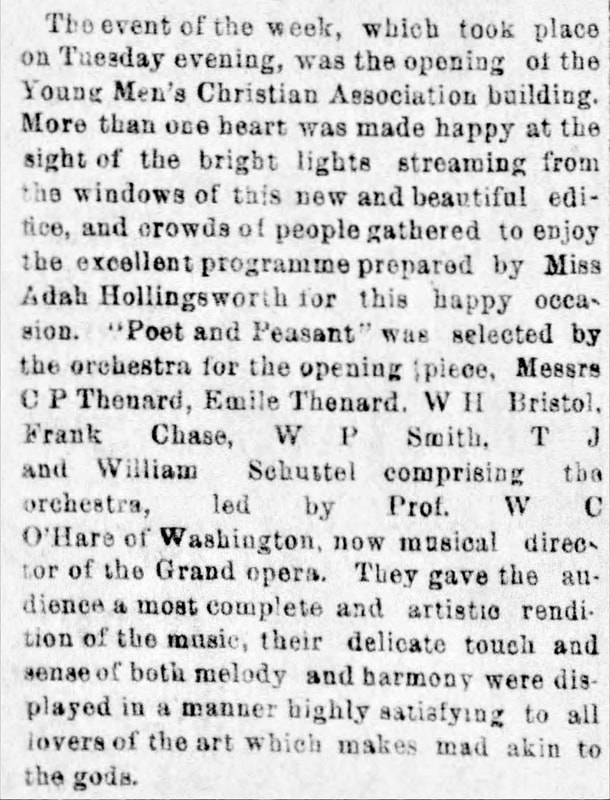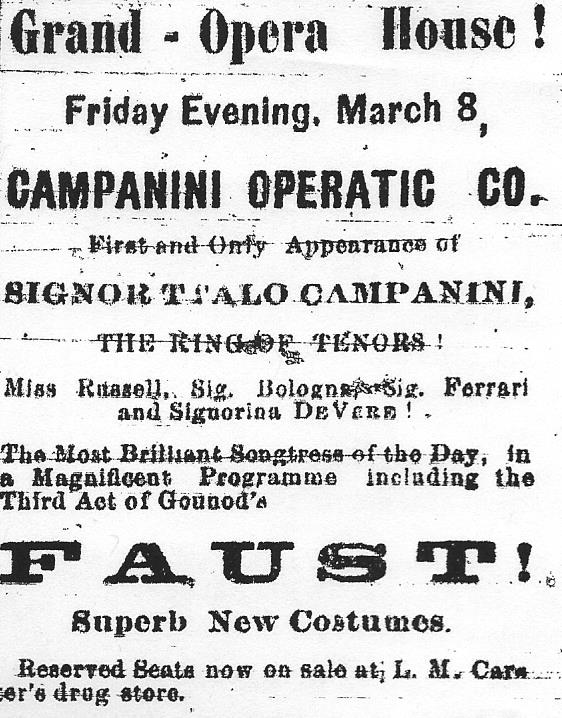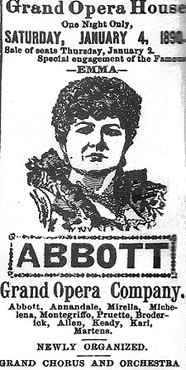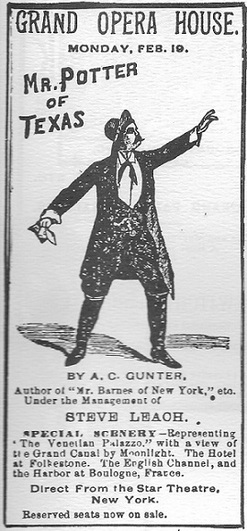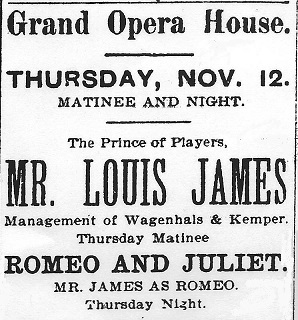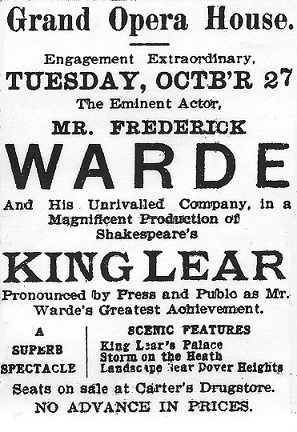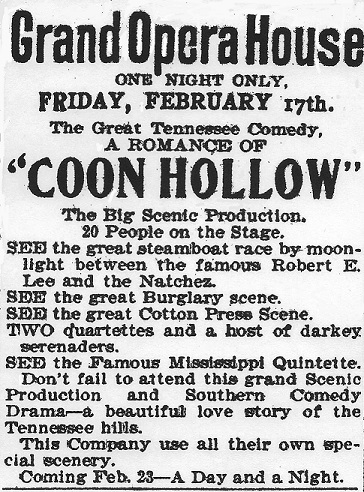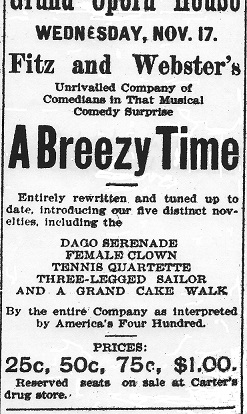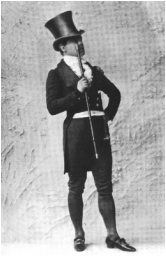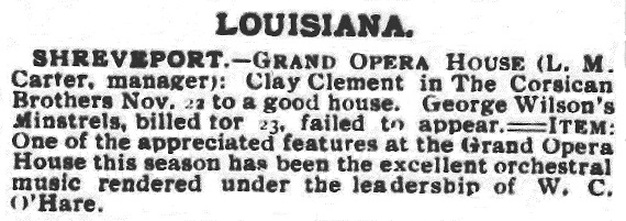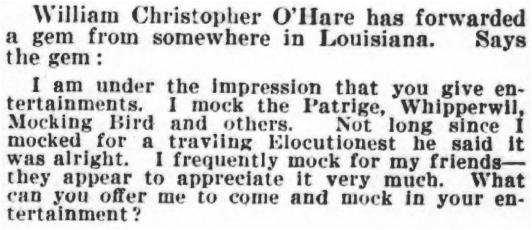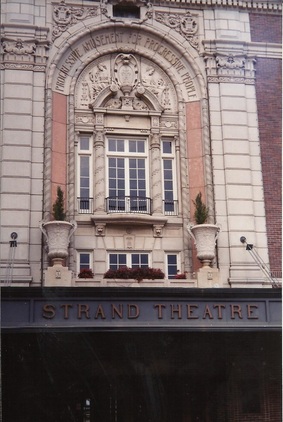The "Queen of the Valley" Builds a Bigger Opera House
|
Prior to the construction of the Grand Opera House, Shreveport was home to a succession of small theater houses, the best of which was Crisp's Gaiety Theater, constructed after the Civil War and opening in 1871. Soon changed to Talley's Opera House, the theater had only a small stage on the second floor of a two-story building, housing businesses on the ground floor. With no electricity or heat, a seating capacity of 150 if seats were crowded together, a curtain mounted on a large spool, and an adjoining dentist's office used as the performers' dressing room, Talley's still managed to attract some major names such as Lawrence Barrett and Edwin Booth.
According to Lilla McClure and J. Ed Howe's History of Shreveport (1937), the growing town had long been "recognized as a good show town but sadly lacking in adequate theatre equipment." As a result, touring companies began bypassing Shreveport. Fortunately, for William Christopher O'Hare, times were changing. With what would become known as the "Gay Nineties" on the horizon, Shreveport, "Queen of the Valley," spoke of modernization: "Progress is the order and fossils are getting out of the way or becoming electrified and determined to keep up with the procession, headed as it is by the young men of the city." |
Shreveport would soon attract 21-year-old O'Hare to fill a job in its new theater. Capable of seating more than 1,000, the Grand Opera House, at the corner of Texas and Edwards, was designed to replace Tally's Opera House, enabling Shreveport to accommodate prominent performers.
From its planning stages, the Grand had quickly become a popular topic, and its size and features would undoubtedly have appealed to a young man who had been teaching music and leading a small band at local venues, such as a Catholic school:
From its planning stages, the Grand had quickly become a popular topic, and its size and features would undoubtedly have appealed to a young man who had been teaching music and leading a small band at local venues, such as a Catholic school:
The gentlemen who have been canvassing and soliciting deserve much praise for their efficient work. The projected building is now a certainty, and in the near future it will be in the hands of the builders. This is only the initiative step in the grand march of progress and prosperity before us. Let the good work go on." --March 1887
The opera house is to be constructed in a most substantial manner and will be provided with all the latest scientific improvements. The front of the building will be faced with fine pressed brick, ornamented with stone and terra cotta work. The interior of the building promises to be an architectural beauty, with a seating capacity of one thousand people, with eight elegant boxes, orchestra, dress circle and balcony, besides a large promenade and lobby for the convenience of the spectators between acts. Ample dressing rooms and all the requisites that will add to the comforts of the actors have received full consideration. The stage will measure fifty feet to the rigging loft and will have a width of thirty-four feet by a depth of thirty-six feet. --July 1887
Our new opera house is asserting itself; it is evident that the new president, James F. Utz, is asserting himself. . . . Leon M. Carter promises some strong attractions the coming season. He is receiving letters of inquiry daily from the best companies traveling. --May 1888
The sash and doors ordered through Wm. Enders & Sons for the opera-house have arrived. It is said they are very handsome and attractive. --May 1888
Manager Carter has put his booking for the new opera house in the hands of Klaw & Erlanger. Look out for something good. --June 1888
The new opera-house is gradually growing more attractive. The work on the outside will soon be completed when the efforts of the artists will be centered in embellishing the interior. The Shreveport opera-house, when finished, will be an ornament to this city and state. --June 1888
The July 2, 1976 issue of the Shreveport Journal describes the Grand Opera House and what it meant to those who frequented it:
The Grand was something Shreveporters could shout about. Where the Talley was bleak, the Grand was plush and where the Talley was decidedly uncomfortable, the new opera house was opulent with thick red carpeting and gold gilt trappings. It was considered one of the finest buildings of its kind in the South.
There were gilded box seats where local ladies could display the latest styles and nod archly to each other across the aisles. Today we would say it was very "in" to be seen at the Grand. . . .
The impressive structure became definitely the hub of culture on the corner of Texas and Edwards streets. And, the Grand went further than displaying its richness of stars. It brought to Shreveport the first glimmerings of theater society. Finally, society had a place in which to meet, to be chic and to, of course, be seen.
Arrival in Shreveport
Although William Christopher O'Hare's hiring and arrival dates are uncertain, early 1889 Shreveport Times news items indicate probable arrival before the end of 1888, certain arrival by the beginning of 1889. By January 1889, he had formed an orchestra scheduled to play a January 29 benefit concert for the opening of the new Shreveport YMCA. The concert was eventually delayed to February 5.
What O'Hare told the opera house developers to convince them to hire him will almost certainly remain a mystery. One thing was certain: despite his limited experience, the Grand's young orchestra leader knew how to appeal to his new Southern community. Following the benefit, a Shreveport social columnist praised the recently formed orchestra and its director, calling special attention to the opening piece and the patriotic climax:
What O'Hare told the opera house developers to convince them to hire him will almost certainly remain a mystery. One thing was certain: despite his limited experience, the Grand's young orchestra leader knew how to appeal to his new Southern community. Following the benefit, a Shreveport social columnist praised the recently formed orchestra and its director, calling special attention to the opening piece and the patriotic climax:
Grand Opera at the Grand Opera House
Sampling of Other Touring Productions at the Grand Opera House
When music wasn't the center of attraction, the Grand again appealed to a variety of tastes ranging from Shakespearan tragedy to rube comedy and vaudeville.
The Role of the Music Director
In his capacity as the Grand's music director, O'Hare programmed and directed music performed throughout the year. Even when a major actor and dramatic production were the evening's main attraction, the Grand's orchestra provided supplemental entertainment. An example appears in the Shreveport social columnist's account of Richard Mansfield's 1893 appearance in Beau Brummel:
There was a well-filled house to greet Richard Mansfield as Beau Brummell at the Grand on Friday evening, and Pansy voices the sentiments of the people in saying it was the best dramatic treat of the season, one scene alone being worth twice the price of admission. . . . The orchestral programme, especially arranged by Prof. W. C. O'Hare, was excellent and consisted of the following music: Poet and Peasant, Imps and Goblins, Ecentrique [sic], Olympic. The members of the orchestra were in full evening dress. |
Shreveport regularly expressed its appreciation of the Grand's orchestra and its leader.
The Grand sometimes hosted non-entertainment events, just as its orchestra performed at outside events:
On last Friday night the Opera-house was filled to its utmost capacity, by a refined, intellectual, appreciative audience, come to witness the Closing Exercises of the High School, the graduation of the class of '97 . . . The Rev. Dr. W. T. D. Dalzell presented the graduates their diplomas, addressing a few words to the audience and occasional remarks to the recipients in his usual easy, jovial manner, and Prof. W. C. O"Hare's Orchestra, Mrs. T. E. Poleman, leading on the piano, discoursed sweet melodies during the evening, that gentleman's musical perfections and the proficiency of the gentlemen of his Orchestra are too well recognized facts to need comment." --May 1897
The home of the Benevolent Protective Order of Elks, No 122 of this city, has been the scene of may elegant and enjoyable entertainments and an announcement a week ago that a reception would be tendered Miss Jenny Calef and company [a professional acting troupe] caused a flutter of delightful excitement among those receiving invitations. . . . Of course Miss Calef and company were special guests and every courtesy was extended them, with many thanks for their delightful entertainment. Prof. O'Hare's orchestra furnished the music for the dancers, and it was early morning before the spacious hall . . . was deserted. --March 1890
In 1899, a New Orleans paper reported O'Hare's positive critique of an 11-year-old prodigy, William Harfield Stockwell, who had give a vocal recital at the Grand Opera House: "It is one of the rarest things in life to hear a young musician interpret the masters with intelligence, but this little boy comes very close to a mature idea of the work. In his recital of the Chopin numbers, notably the 'Nocturne,' opus 37, No 2, they thrilled his auditors, and were beyond their expectations, as were likewise the Mendelssohn and Rubinstein pieces. The Chaminade offerings, 'Flatterer' and 'Dance of the Jugs,' were executed in a brilliant style." [Note: Public records indicate that Stockwell became a music teacher in Shreveport (1917) and Oklahoma City (1920). He died later the same year in San Diego, where his family had moved from Shreveport when he was an infant.]
A Touch of Humor
Fate of the Shreveport Grand Opera House
|
The Grand survived for roughly a quarter century after O'Hare's departure from Shreveport.
In 1923, rather than spend $250,000 remodeling the Grand Opera House, Shreveport opted to spend $750,000 on a new theater with the Grand to be used as a movie and vaudeville theater. The Grand was demolished in 1926. The new theater was built across the street from W. C. O'Hare's former Shreveport residence at 702 Crockett Street. The beautiful Strand has not only survived but remains in active use. |
Background Image, top of page: the Shreveport Grand Opera House
